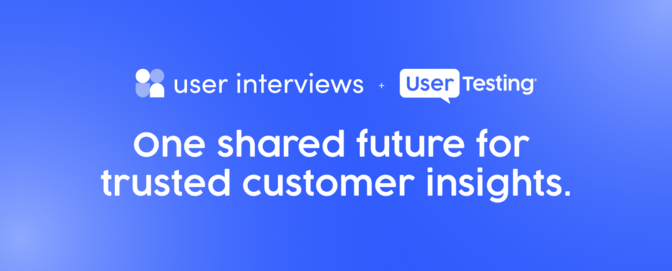
What is a user research discussion guide and why do you need one?

Regardless of who you invite into your research, you need a plan of action and a basic understanding of what to ask them. Users, non-users, users who require additional accessibility options, or even the users no one expected to find. All bring different perspectives to your product. You usually only have an hour with each person, so you want to make the most of that time in the most efficient way possible.
Discussion guides help you do just that, but what does a good discussion guide look like, and how can they help? We've compiled some handy information on creating and implementing discussion guides to improve your research results.
What are discussion guides?
A discussion guide is a rough plan of what will happen and the questions to ask in a user interview. It should cover everything. Your introduction of the session, each topic you’re covering, a scenario and questions, and a wrap-up for the entire session.
Discussion guides need to be used while you're moderating the session. They need to be designed to be easy to read and use while you focus on other aspects of the interview.
Don’t forget. You're not just asking questions at that moment. You’re also time managing, listening to the language the participant is using, rephrasing questions, paying attention to body language, and crafting a conversation. There are so many things to keep track of, so a guide is there for you to fall back on when you’ve lost your place, or you need to get back on track after exploring unexpected insights.
The more interviews you have, the more difficult it is to remember which questions you have asked each participant. The discussion guide is also like a checklist of user research questions. You can print as many discussion guides as you need to and take notes as you go along. This helps to keep track of which questions have been asked. For a more sustainable option, you can always dust off your iPad Pro and take notes on a PDF with the Apple Pencil. These notes will help you circle back when participants mention multiple interesting things at once and jog your memory during analysis.
How are discussion guides used?
The accuracy and consistency you need from your user data will influence how you use your discussion guide. If you conduct academic or academic-like research, you want to be as consistent as possible. You'll need to be aware of the order you ask questions and ensure you ask as many of your planned questions as possible to have a consistent data set.
For industry interviews, the guides are not used as religiously. Sometimes people refer to discussion guides as scripts, but this can remove the permission or feeling that you can diverge from what’s written.
You cannot preempt how a conversation will go or plan every possible question. More often than not, participants will say something unexpected and exciting that needs to be explored. Go for it! Explore interesting avenues. Just know that when the conversation runs dry, you can fall back on your discussion guide to pick up where you left off.
Confidence is key to building rapport but also maintaining that rapport with participants. Especially when you only have an hour of someone’s time and so much depends on the research.
Use discussion guides to plan the length of interviews you need. Is it five small sections or two long sections with tasks involved? Over time, you'll understand how long a section will take depending on complexity and length. You can then look at each section and see if the order makes sense as part of a common user journey.
Let’s say you want to explore paying for an order with a gift card, how filters are used to browse for inspiration, and finding vouchers or deals for an order. If you take users through these sections of the website in this order, you ask people to finalize an order before they have found an item. This means users are going back and forth on the website. It’s exhausting having to repeat actions to complete tasks. This isn’t a natural way of using the website. In a discussion guide, you can conduct a dry-run in your mind to see if the journey of the sections is as consecutive as possible, leading into one another organically.
Why should you use discussion guides?
Discussion guides are useful and important for multiple reasons and across all disciplines within your team. Firstly, they're important for researchers because it gives you structure, consistency, and support. Moderating is exhausting; regardless of how experienced you are, some people are difficult to interview or converse with. Conversations can run dry, and you’ll need to regroup when you have finished exploring an unplanned insight.
Secondly, they provide a way of communicating the questions before the study. Sharing the document beforehand gives those not participating in the interviews a chance to ask their own questions. This helps people like developers or quality analysts who may not have a lot of time to get involved in research to be still user-centric. This helps build design confidence when developers or product owners have seen first-hand where the design decisions stem from.
Discussion guides also allow you to go into a session with everyone on the same page.
Writing down the questions shows your interpretations of the research objectives. Finding out there were nuances in interpretations during the analysis phase is too late and is an expensive mistake that discussion guides can help avoid. Of course, there can always be that one other question you would love to go back and ask, but that can happen with or without a discussion guide.
Discussion guides are also useful for documenting your research after the project has concluded. A discussion guide provides your future self and future researchers with a thorough record of what the project needed to achieve and what users were asked to achieve those goals.
You often need to review previous research to see if current research questions have been asked before. The ability to search for existing research topics is a quick and easy way to see if you need to start from scratch or can give stakeholders insights in the meantime.
What should you include in a discussion guide?
There’s no right or wrong way to do a discussion guide. They’re simply a tool to guide you through an interview, so it’s difficult to say what should or shouldn't always be included. However, some legal and ethical pointers should be considered, and a variety of guides and templates out there to help get you started. Note that this is not a script, so bullet points are best for keeping it easy to read and then elaborate on.
Research objectives
First, add the metadata of the interviews and project. Think of it as a record for your future self. Add the main research objectives that are being achieved in interviews using this discussion guide. Provide as much context as possible, like you’re explaining the research to someone new to the company. Keep it succinct, and if it’s a lot of detail don’t forget to hide the text while you‘re using the discussion guide in interviews.
Introduction and background questions
Next, you’ll need an introduction. Ease your user into the hour, by letting them know who you are and what the hour will involve. It’s always a good idea to let them know whether the session is being recorded or if others are observing it from outside the room.
Reassure them that they can take breaks and ask questions to clarify and most importantly how the data is being captured and stored. Finally, encourage them to think aloud through the session, which is about to begin!
Then come your background questions. Here, you want to ask questions that gauge the emotional investment of your participant.
Let’s say you’re exploring the usability of a checkout. You want to ask questions about what your user normally shops for, when they usually shop and where. Get them into their mindset as much as possible. This way you can get an idea of their story and why they may behave in certain ways.
Would they normally be with their children and therefore more distracted while shopping online? Would they browse on mobile but make the purchase on desktop? Would they be going through the user journey you’re asking them to?
To get you started, here are a few questions:
- What do you normally do online?
- Where do you tend to be when you do shopping online?
- What devices do you use when you look online for products?
- How do you choose a website to click on when you look through the Google results?

Topic Sections
Topics are the real meat of the discussion guide. Each topic should be a section covering everything you need to test or explore. Think of it as a high-level checklist of the areas the participant should have gone through by the end of the interview.
Defining sections can be tricky - how can you define where one ends and the next one begins? Let’s say you have the following questions from stakeholders you need to answer:
- Do users want the ability to pay for orders in installments?
- Why are users landing on the homepage and what are they doing there?
- How do users decide what products to click on?
These questions touch on checkout, payments, search, navigation, exploration, and homepage. Of course, exploring checkout before the homepage would take users through repetitive sections, so reordering the sections is necessary. Re-order sections even if the priority order is not the same. A discussion guide should be as user-centric as your designs. So, for these questions, you could have something along the lines of:
- Homepage - Including asking participants how to find websites in the first place. Maybe they search on Google which takes them directly to a product without landing on the homepage
- Search and Navigation - Participants find a product and are asked how they decide what products to click on
- Checkout and Installments - Using the product a participant has just found, get them to go through the checkout process
The wrap-up
After the fun of going through the website, it’s time for a recap. Here, you want an overview of their experiences. What were the stand-out positive and negative parts of the site? Asking for somewhat repetitive information here provides a sense of the importance of issues that are worth stressing.
You can also confirm the emotional investment of the participant at this point.
Asking questions like “How likely are you to have used a website like this to achieve a goal like this?” and “How likely are you to want to use a website like this?” helps provide perspective as to whether your participant would have gone through this scenario, as well as the website itself. If it’s not realistic for this participant, the insights are still valuable but there are probably gaps that need to be filled in by additional participants.
Next, give them a chance to share any thoughts they had that may not have been covered in a question. They might give you a golden nugget about the website experience that was just not covered by your topics. Finally, let them know about the incentive for their time and then always thank them for their time and feedback.
What doesn't go into a discussion guide?
Questions for participants are the main focus. Text which isn’t moderation-focused or not relevant to the interviews will mask what’s important and will only make the questions difficult to read during your interview session. There should be no confusion as to what to say to the participant.
It also helps to write the questions in the way that they need to be said. While we cannot stress enough that it’s not a script, a discussion guide full of leading questions is less useful than no discussion guide at all. And if need be, you can always elaborate. Just make sure it is still a well-structured question.
Next steps: How to introduce discussions guides to your team
Sometimes getting people on board with changes can be daunting and discussion guides can appear to be more work than they’re worth. Why would you write down questions when you know what to ask users? You’ve been talking to them for years.
Well, they’re not the same questions as before and research is not just for you. Discussion guides are a tool of communication with those not in the interviews and a record of what research has been done for you and those who follow in your footsteps. For example, what happens if you’re ill on the day of testing and need to hand over questions to a team member?
Discussion guides prove their worth from the moment you start doing them. The easiest step is to lead by example and write the first one. Find a template, tweak it, send it around to people to involve them, and start discussions to uncover what else you can ask users. There are so many example questions to use that they don’t even take long to write. Store discussion guides alongside other research assets like videos, transcriptions, and survey reports making them accessible and easy to find for everyone. Once the team’s first discussion guide has been done, others can easily follow.

Watch a demo
See how easy it is to get fast feedback on a website, prototype, design, or more in this demo.





